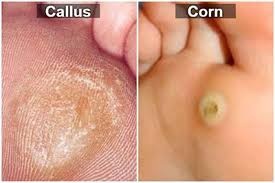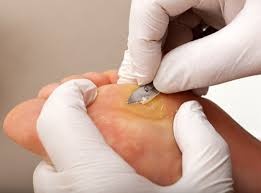

Corns and Calluses
Corns and Calluses Corns and calluses are thick, hard, toughened and dry areas of skin found on the feet. They are caused by friction or pressure from shoes, adjacent bones, or the ground as you walk. They are found anywhere on the feet and can range from very mild to very severe ulcerated/broken down areas which can also be infected. Corns and calluses can cause foot pain and can be very painful.
A corn is a small conical shaped area of hard dead skin which presses on the underlying nerve endings and can often cause intense pain. They are normally quite small and round in shape. They are caused by friction and pressure from shoes and the ground surface. They can be found anywhere on the foot but are more commonly found on the ball of the foot and on the top of the toes. Occasionally they are found between the toes. They are often easily removed or reduced in size by a chiropodist or podiatrist giving instant relief from pain.
Soft Corns
Soft corns are found between the toes, most commonly between the 4th and 5th toes. They are caused by the adjacent toe bones rubbing against each other. They are "soft" because of the dampness between the toes which keeps them moist. They can become infected. They often look white and rubbery. Sometimes athletes foot (a fungal infection) is also found in the area of the soft corn.
Callus
A callus is a larger area of hard dead skin but has no central core like a corn. It is normally less well defined than a corn. Calluses are caused by rubbing, friction and/or pressure from shoes and the ground surface. Calluses are commonly found on the sole of the foot over the metatarsal bones. Calluses might not cause any discomfort but with time or increasing thickness and size can cause a painful burning sensation on the sole of the feet.
What causes corns and calluses?
- Tight shoes and socks
- Seams in inappropriate places
- Deformed and crooked toes (for example a hammer or claw toe which rubs on the top of a shoe)
- Deformed feet (for example a bunion and the bony prominences which rubs on the side or top of the shoe)
- Biomechanical /overloading in certain areas on the feet (can cause pressure in an isolated place on the plantar surface (bottom) of the foot)
- Dry skin
- Age - older skin is less elastic and much more likely to get damaged
Shoes and footwear
Shoes should be the correct size, not too small or too large.
Shoes should have plenty of room in the toe box area for the toes, particularly if you have hammer or claw toes, have soft uppers, low heels and plenty of support on the medial (inner) side of the shoe.
Carefully avoid shoes that have stitching in inappropriate places for you.
A slightly flared out heel offers much greater stability than a heel that flares in.
Treatment from Chiropodist or Podiatrist
Paring Corns and Calluses
A chiropodist or podiatrist will carefully pare (cut) the dead skin away with a scalpel blade. Regular treatment is often needed to control the build up of hard skin.
Footwear and Orthotics
A chiropodist or podiatrist can advise on correct footwear, padding and orthotics (insoles or arch supports to correct walking and biomechanical problems) to try and prevent the build up of corns and calluses.
Padding
A chiropodist or podiatrist can advise on padding to deflect pressure away from area.
